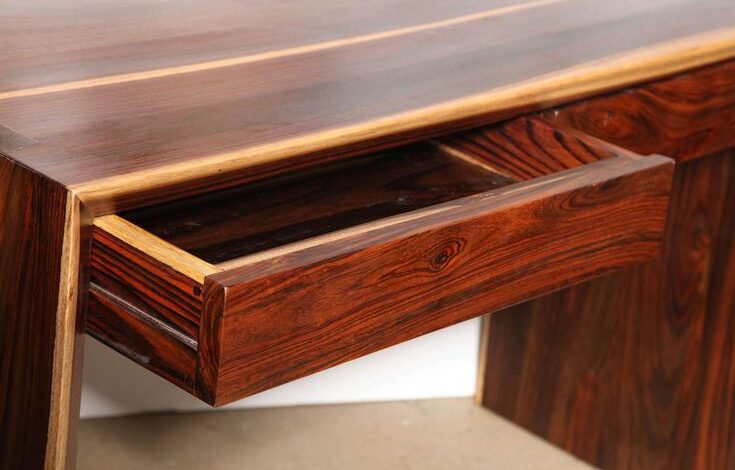The Allure of the Cocobolo Desk

In the vast realm of furniture artistry, few materials can evoke such fascination as Cocobolo. Derived from a slow-growing tree in Central America, cocobolo wood has become synonymous with luxury, durability, and a unique aesthetic. But what makes the cocobolo desk so sought after?
History and Origin: Central America, a land of lush forests and rich history, has given birth to the cocobolo tree. Indigenous communities have used this wood for centuries, not just for its beauty but also for its resilience. Over time, as the world saw its rich reddish-brown hue intertwined with intricate grain patterns, cocobolo desks became a statement of elegance and prestige.
Design and Aesthetics: A cocobolo desk isn’t just a piece of furniture; it’s a conversation starter. Each desk is uniquely its own, boasting many colours, from deep oranges to purples and patterns reminiscent of flowing rivers or fiery sunsets. Its glossy finish, achieved naturally, adds a touch of luxury. Hence, the cocobolo desk epitomizes art melded with functionality in a modern minimalist office or a vintage study room.
Maintenance and Care: For all its allure, Cocobolo also demands respect in terms of care. The natural oils in the wood offer a certain level of protection against wear and tear. However, regular dusting, avoiding prolonged exposure to direct sunlight, and occasional oiling can ensure your cocobolo desk remains as enchanting as the day you first set eyes on it.
Sustainability Concerns: With popularity comes responsibility. Overharvesting threatens the cocobolo tree. Hence, for admirers of this magnificent wood, it’s essential to invest in desks sourced responsibly. Sustainable practices not only protect our environment but also ensure that the legacy of the cocobolo desk continues for generations.
The cocobolo desk isn’t just about luxury; it’s a testament to nature’s artistry, human craftsmanship, and our duty towards preserving both.
History and Origin: Tracing the Roots of the Cocobolo Desk
When diving deep into the annals of furniture lore, one is often spellbound by the tales of exotic woods. Among them stands Cocobolo, a majestic emblem of Central American forests. The cocobolo desk, a product of human ingenuity, carries a lineage steeped in mystery, beauty, and evolution. Let’s embark on a journey tracing its origins.
The cocobolo tree, predominantly found in the tropical regions of Central America, from Mexico down to Panama, has long been admired by indigenous tribes. Their connection with this wood was more than just practical. It was a bond, a mutual respect. These tribes identified the durability and resistance of Cocobolo against decay, using it in various applications, from crafting tools to ceremonial items.
But what catalyzed the metamorphosis of this revered wood into the iconic cocobolo desk? As exploration and trade flourished, Cocobolo made its way into international markets. Ever hungry for unique materials, European and North American artisans quickly recognized its potential. Its vibrant hue, ranging from rich reds to deep purples and oranges, juxtaposed with a stunning grain pattern, made Cocobolo a choice material for luxury items. By the 19th century, desks made from this wood began gracing the studios and offices of the elite, symbolizing prestige, luxury, and an appreciation for fine artistry.
However, the allure of the cocobolo desk is not just its visual appeal. It’s a story, a history of human discovery and innovation. It’s about our inherent desire to integrate the beauty of nature into our everyday lives. It’s a narrative of artisans and craftsmen tirelessly sculpting and refining, ensuring each cocobolo desk becomes a legacy piece.
As we admire these desks today, we are not just looking at a piece of furniture. We are connecting with the past, indigenous traditions, explorers, and artisans who believed in the magic of Cocobolo.
Design and Aesthetics: Why Cocobolo Stands Out in Craftsmanship
Cocobolo remains a jewel in the crown of craftsmanship in a world overflowing with materials. It’s not just wood; it’s an ode to nature’s grandeur and human aspiration. The pivotal question is, what makes Cocobolo an unparalleled spectacle in design and aesthetics, especially when fashioned into desks?
At the heart of Cocobolo’s magnificence is its vibrant colour palette. Deep, fiery reds intersperse with shades of orange, occasionally peppered with dark streaks or purple undertones. Each plank is a canvas, with nature having painted an abstract masterpiece of hues and tones. When human hands mould this wood, the result is a piece that doesn’t just serve a function but tells a tale of forests, sunsets, and earth.
The grain pattern further elevates Cocobolo’s appeal. Unlike many other woods, its grains swirl, dance, and meander, creating ways that can be likened to landscapes or waves. When artisans choose a particular slab for a desk, they choose a story waiting to unfold.
Craftsmanship with Cocobolo is an art of reverence. It demands precision, patience, and passion. The wood is dense and oily, making it both a challenge and a delight for woodworkers. The oils provide a natural sheen, enhancing its visual depth, while the density ensures a product that will stand the test of time.
And it’s not just about the Cocobolo itself. It’s about how it integrates with other elements. Brass or gold inlays, leather surfaces, and complementary woods often accompany cocobolo desks, culminating in a regal and warm design.
Cocobolo’s unmatched beauty lies at the intersection of its natural attributes and human ingenuity. It stands as a testament to what can be achieved when the wonders of nature are met with the finesse of skilled craftsmanship. Every cocobolo desk is not just furniture but a piece of art, a confluence of earth and human spirit.
Maintenance and Care: Ensuring Your Cocobolo Desk Ages Gracefully
Every prized possession has an implicit responsibility: to care for and cherish it. Cocobolo desks, with their majestic aura, are no exception. Just as they are crafted with love and precision, they should be maintained with the same dedication. Here’s a guide to ensuring your cocobolo desk stands the test of time, ageing with elegance and grace.
The cocobolo tree imparts its wood with rich, natural oils. These oils bestow the wood with a natural sheen and act as a protective barrier against potential damage. However, more than relying on these natural attributes is required. Human intervention, in the form of regular maintenance, plays a pivotal role.
Dusting Regularly: Dust, seemingly harmless, can accumulate and dull the radiant finish of a cocobolo desk. Use a soft cloth to wipe your desk regularly, maintaining its natural sparkle. Avoid abrasive materials that might scratch its surface.
Avoiding Direct Sunlight: While Cocobolo’s colours are vibrant and robust, prolonged exposure to direct sunlight can fade them. Place your desk where it’s shielded from harsh UV rays, or use protective blinds or curtains.
Oil Treatment: Although Cocobolo is naturally oily, occasional oiling can enhance its lustre. Once or twice a year, consider applying a light mineral oil or a specialized wood oil. This not only rejuvenates its look but also offers an additional protective layer.
Promptly Addressing Spills: If you spill any liquid on the desk, wipe it off immediately. Allowing it to sit might stain the wood or interfere with its natural oils.
Avoiding Chemical Cleaners: Stick to natural cleaners. Harsh chemicals can strip Cocobolo of its natural oils, diminishing its glow and longevity.
A cocobolo desk is more than just a functional piece; it’s a living, breathing testament to nature’s splendour and human artistry. By following these care steps, you’re not just maintaining a desk but preserving a legacy, ensuring that the allure of Cocobolo remains undiminished for years to come.
Sustainability Concerns: The Environmental Impact and Responsible Sourcing of Cocobolo
With its mesmerizing hues and intricate grain patterns, Cocobolo is undeniably a gem among timbers. Yet, behind its beauty lies a pressing concern: sustainability. As demand for Cocobolo grows, so do the threats to its native forests in Central America.
Harvesting Cocobolo has a significant environmental impact. Rapid deforestation to meet global demands disrupts ecosystems and threatens biodiversity. As the cocobolo tree is slow-growing, overharvesting jeopardizes its survival, pushing it closer to extinction.
The solution? Responsible sourcing. The call is not to abstain from using Cocobolo but to ensure that when we do, it’s sourced ethically. Certifications, like those from the Forest Stewardship Council (FSC), can guide consumers towards sustainably harvested Cocobolo. These certifications guarantee that the wood is sourced from forests managed with care, preserving ecosystems and supporting local communities.
Moreover, recycling and repurposing older cocobolo items can reduce the demand for fresh lumber, promoting a circular economy.
In conclusion, while cocobolo desks symbolize luxury and craftsmanship, they should also represent a commitment to the environment. By advocating for and supporting responsible sourcing, we can enjoy the beauty of Cocobolo without compromising our planet’s health.
Also, Read The Following: balance



